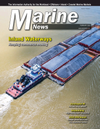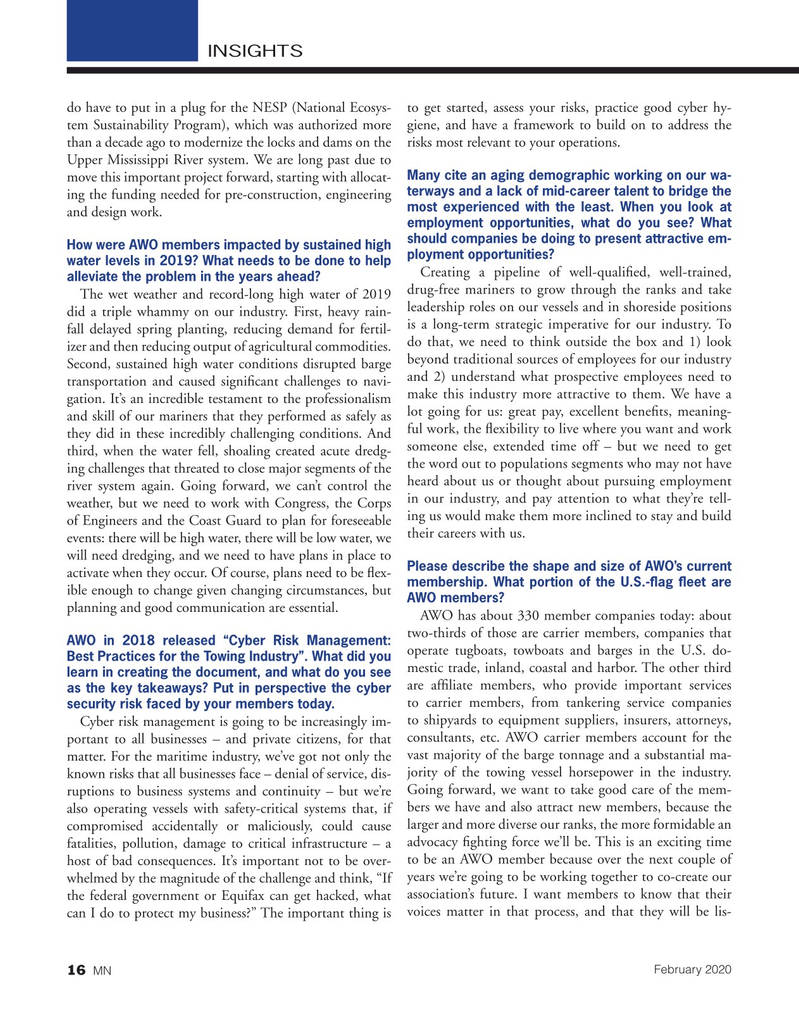
Page 16: of Marine News Magazine (February 2020)
Pushboats,Tugs & Assist Vessels
Read this page in Pdf, Flash or Html5 edition of February 2020 Marine News Magazine
INSIGHTS do have to put in a plug for the NESP (National Ecosys- to get started, assess your risks, practice good cyber hy- tem Sustainability Program), which was authorized more giene, and have a framework to build on to address the than a decade ago to modernize the locks and dams on the risks most relevant to your operations.
Upper Mississippi River system. We are long past due to
Many cite an aging demographic working on our wa- move this important project forward, starting with allocat- terways and a lack of mid-career talent to bridge the ing the funding needed for pre-construction, engineering most experienced with the least. When you look at and design work.
employment opportunities, what do you see? What should companies be doing to present attractive em-
How were AWO members impacted by sustained high water levels in 2019? What needs to be done to help ployment opportunities?
Creating a pipeline of well-quali? ed, well-trained, alleviate the problem in the years ahead?
The wet weather and record-long high water of 2019 drug-free mariners to grow through the ranks and take leadership roles on our vessels and in shoreside positions did a triple whammy on our industry. First, heavy rain- is a long-term strategic imperative for our industry. To fall delayed spring planting, reducing demand for fertil- izer and then reducing output of agricultural commodities. do that, we need to think outside the box and 1) look
Second, sustained high water conditions disrupted barge beyond traditional sources of employees for our industry and 2) understand what prospective employees need to transportation and caused signi? cant challenges to navi- gation. It’s an incredible testament to the professionalism make this industry more attractive to them. We have a and skill of our mariners that they performed as safely as lot going for us: great pay, excellent bene? ts, meaning- they did in these incredibly challenging conditions. And ful work, the ? exibility to live where you want and work someone else, extended time off – but we need to get third, when the water fell, shoaling created acute dredg- ing challenges that threated to close major segments of the the word out to populations segments who may not have river system again. Going forward, we can’t control the heard about us or thought about pursuing employment weather, but we need to work with Congress, the Corps in our industry, and pay attention to what they’re tell- of Engineers and the Coast Guard to plan for foreseeable ing us would make them more inclined to stay and build events: there will be high water, there will be low water, we their careers with us. will need dredging, and we need to have plans in place to
Please describe the shape and size of AWO’s current activate when they occur. Of course, plans need to be ? ex- membership. What portion of the U.S.-

 15
15

 17
17
